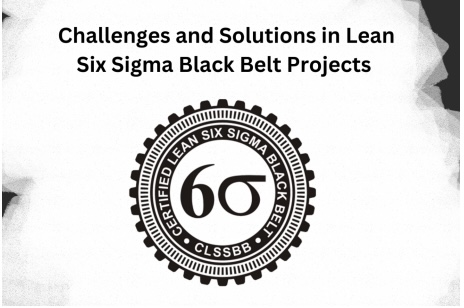
When driving organisational improvement and achieving business goals, Lean Six Sigma Black Belt projects are essential. Professionals with Lean Six Sigma Certification work on these projects and efficiently help the organisation to complete the projects successfully. These projects frequently encounter several challenges. Several common challenges with Lean Six Sigma Black Belt projects will be discussed in this blog, along with some suggestions for fixing them.
Difficulties with Lean Six Sigma Black Belt Projects
Stakeholder Resistance
Stakeholder opposition is a significant obstacle for Lean Six Sigma Black Belt projects. Managers, workers, and other interested parties may all be hesitant to embrace novel approaches or procedures, leading to resistance to change. To overcome stakeholder opposition, stakeholder engagement, good communication, and change management tactics are necessary.
Data Availability and Quality
Data quality and availability issues can be very problematic for Lean Six Sigma Black Belt initiatives. Problems with data quality or quantity can slow down analysis, increasing the likelihood of erroneous findings and inefficient solutions. Thorough data collection, validation, and cleansing processes must address data availability and quality challenges. Collaborating with data owners and stakeholders to ensure correctness and completeness is also essential.
Project Scope Creep
When a Lean Six Sigma Black Belt project’s scope grows beyond its initial parameters, it causes problems like delays, cost overruns, and decreased effectiveness, known as scope creep. Preventing scope creep through effective management of the project’s scope necessitates regular communication and alignment with project stakeholders, in addition to well-defined project objectives and procedures for managing the project’s scope.
Resistance to Change
Another typical issue encountered in Lean Six Sigma Black Belt projects is resistance to change. Concern about the future, a desire for more autonomy, or a belief that their current positions are in jeopardy are reasons workers may be hesitant to adopt new procedures, technologies, or approaches. Communication, training, participation, and the backing of leadership and stakeholders are all essential components of effective change management tactics that can help overcome resistance to change.
Resource Constraints
Lean Six Sigma Black Belt projects may encounter roadblocks due to a lack of resources, such as time, money, or qualified staff. Projects must be well-planned, allocated, and prioritised to make the most of limited resources, and all available resources must be fully utilised.
Solutions to Overcome Challenges
Stakeholder Engagement
Effective stakeholder interaction is crucial in overcoming opposition and obtaining buy-in for Lean Six Sigma Black Belt projects. Building trust and alignment with stakeholders requires early and consistent engagement throughout the project lifecycle, regular communication of project goals, benefits, progress, and stakeholder participation in decision-making.
Data Governance
Implement strong data governance practices to ensure that data for Lean Six Sigma Black Belt initiatives is available, high-quality, and secure. Work with data owners and stakeholders to establish controls, procedures, and standards for collecting, validating, and cleaning data.
Project Management
Implementing robust project management methods ensures that Lean Six Sigma Black Belt projects are well-managed in scope, time, money, and resources. Project goals, scope, and deliverables should be defined in advance, along with milestones and dates. It is essential to regularly monitor project progress to detect and handle any difficulties that may arise proactively.
Change Management
Lean Six Sigma Black Belt projects can benefit from incorporating change management ideas and techniques to help overcome opposition and ensure successful adoption. To assist employees in successfully adjusting to change, create a thorough change management plan incorporating training, stakeholder participation, communication, and support systems.
Continuous Improvement
Drive long-term success in Lean Six Sigma Black Belt projects by addressing difficulties and promoting an organization-wide culture of continuous improvement. Incorporate lessons learnt into future projects’ processes, techniques, and practices by encouraging reflection, feedback, and learning from past experiences.
Conclusion
Project scope creep, stakeholder opposition, data availability and quality concerns, resource limitations, and resistance to change are just a few of the obstacles that can derail Lean Six Sigma Black Belt initiatives. Project management, data governance, stakeholder involvement, change management, and continuous improvement strategies are practical solutions organisations can use to overcome these problems and accomplish their goals. Organisations can boost their long-term performance and competitiveness by proactively addressing challenges and using best practices and lessons learned from Lean Six Sigma Black Belt projects to improve quality, efficiency, and customer satisfaction. For more information visit: The Knowledge Academy.





